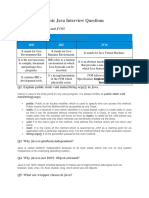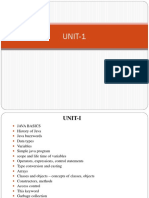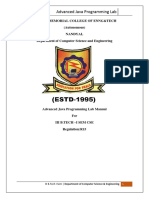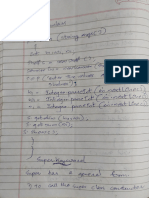Java 1 Mark
Uploaded by
Leslie QwerJava 1 Mark
Uploaded by
Leslie QwerJava 1 mark
1. What is JDBC in Java?
Java database connectivity (JDBC) is the JavaSoft specification of a standard application
programming interface (API) that allows Java programs to access database management
systems. The JDBC API consists of a set of interfaces and classes written in the Java
programming language.
2. What is jvm, JDK, JRE?
■JVM (Java Virtual Machine) is a very important part of both JDK and JRE because it is
contained or inbuilt in both. Whatever Java program you run using JRE or JDK goes into JVM
and JVM is responsible for executing the java program line by line, hence it is also known as
an interpreter.
■JDK (Java Development Kit) is a Kit that provides the environment to develop and
execute(run) the Java program. JDK is a kit(or package) that includes two things
Development Tools(to provide an environment to develop your java programs)
■ JRE (to execute your java program)
■JRE (Java Runtime Environment) is an installation package that provides an environment
to only run(not develop) the java program(or application)onto your machine. JRE is only used
by those who only want to run Java programs that are end-users of your system.
Q3. multiple classes
Java is an object-oriented programming language. You can create multiple classes in Java
and create a class hierarchy such that one class can call another class. Do not confuse this with
Java inheritance because, in class inheritance, there is a parent-child relationship between
classes.
Q4.w hat is Super class in java?
the superclass, also known as the parent class , is the class from which a child class (or a
subclass) inherits its constructors, methods, and attributes. For instance, in our above example,
BankAccount was the superclass from which our subclass SavingsAccount inherited its values.
Q5. What is the use of final keyword in java?
The final keyword in java is used to restrict the user. The java final keyword can be used in
many context. Final can be:
●variable
●method
●class
The final keyword can be applied with the variables, a final variable that have no value it is
called blank final variable or uninitialized final variable. It can be initialized in the constructor
only. The blank final variable can be static also which will be initialized in the static block only.
Q6. What is Java API?
Java application programming interfaces (APIs) are predefined software tools that easily
enable interactivity between multiple applications.
APIs are important software components bundled with the JDK. APIs in Java include classes,
interfaces, and user Interfaces. They enable developers to integrate various applications and
websites and offer real-time information.
7.What is Unicode?
The Unicode Standard is the universal character representation standard for text in
computer
processing. Unicode provides a consistent way of encoding multilingual plain text making it
easier to exchange text files internationally.
ASCII defines 128 characters, which map to the numbers 0–127. Unicode defines (less than)
2^21 characters, which, similarly, map to numbers 0–2^21
The Unicode Standard provides a unique number for every character, no matter what
platform, device, application or language.
8.What is wrapper class?
The wrapper class in Java provides the mechanism to convert primitive into object and
object
into primitive.
The automatic conversion of primitive into an object is known as autoboxing and vice-versa
unboxing.
Eg: int a=20;
Integer i=Integer.valueOf(a);//converting int into Integer explicitly
Integer j=a;//autoboxing, now compiler will write Integer.valueOf(a) internally.
Q9. What is thread in java?
A thread is a thread of execution in a program. The Java Virtual Machine allows an
application to have multiple threads of execution running concurrently.
Every thread has a priority. Threads with higher priority are executed in preference to threads
with lower priority. Each thread may or may not also be marked as a daemon. When code
running in some thread creates a new Thread object, the new thread has its priority initially set
equal to the priority of the creating thread, and is a daemon thread if and only if the creating
thread is a daemon.
2types of threads in java
■Daemon thread in Java is a low-priority thread that runs in the background to perform tasks
such as garbage collection. Daemon thread in Java is also a service provider thread that
provides services to the user thread.
■User Thread in java
User threads are also known as non-daemon threads. The user thread is a thread which runs in
the foreground. In case of User Thread, JVM quits an application when all users threads are
completed.
10.What is JIT?
The Just-In-Time (JIT) compiler is a component of the Java™ Runtime Environment that
improves the performance of Java applications at run time. Java programs consists of classes,
which contain platform-neutral bytecodes that can be interpreted by a JVM on many different
computer architectures.
You might also like
- 100+ Java Interview Questions and AnswersNo ratings yet100+ Java Interview Questions and Answers11 pages
- Q1. What Is The Difference Between An Abstract Class and Interface?No ratings yetQ1. What Is The Difference Between An Abstract Class and Interface?13 pages
- Top 371 Java FAQs Useful For Freshers and Experienced86% (14)Top 371 Java FAQs Useful For Freshers and Experienced55 pages
- Core Java Q1. What Is The Difference Between An Abstract Class and Interface?No ratings yetCore Java Q1. What Is The Difference Between An Abstract Class and Interface?233 pages
- Q2. Explain Public Static Void Main (String Args ) in JavaNo ratings yetQ2. Explain Public Static Void Main (String Args ) in Java9 pages
- 150+ Core Java Interview Questions and Answers For Freshers and Experienced in 2023No ratings yet150+ Core Java Interview Questions and Answers For Freshers and Experienced in 202369 pages
- 1) What Is The Difference Between An Abstract Class and Interface?No ratings yet1) What Is The Difference Between An Abstract Class and Interface?8 pages
- Top 34 Java Basic Interview Question AnswersNo ratings yetTop 34 Java Basic Interview Question Answers7 pages
- Important Viva Voice Questions for Advance Java Programming Lab from unit 1(a) basics of javaNo ratings yetImportant Viva Voice Questions for Advance Java Programming Lab from unit 1(a) basics of java5 pages
- Top 25+ Fresher Java Interview QuestionsNo ratings yetTop 25+ Fresher Java Interview Questions16 pages
- Core Java Interview Questions and AnswersNo ratings yetCore Java Interview Questions and Answers10 pages
- Java Technical Interview Questions For FreshersNo ratings yetJava Technical Interview Questions For Freshers11 pages
- Java Basic Questions For Interview PreparationNo ratings yetJava Basic Questions For Interview Preparation20 pages
- JAVA: Java Programming for beginners teaching you basic to advanced JAVA programming skills!From EverandJAVA: Java Programming for beginners teaching you basic to advanced JAVA programming skills!No ratings yet
- J 1417-Information Security (2014 Admn OnwardsNo ratings yetJ 1417-Information Security (2014 Admn Onwards10 pages
- Hacking With Kali Linux - A Comprehensive Beginner's Guide to Learn Ethical Hacking. Practical Examples to Learn the Basics of Cybersecurity. Includes Penetration Testing With Kali Linux by ITC ACADEMY100% (1)Hacking With Kali Linux - A Comprehensive Beginner's Guide to Learn Ethical Hacking. Practical Examples to Learn the Basics of Cybersecurity. Includes Penetration Testing With Kali Linux by ITC ACADEMY91 pages
- Hytera Multi-mode Advanced Radio_API Reference_R10% (1)Hytera Multi-mode Advanced Radio_API Reference_R1328 pages
- Internal Guide:-Mrs. A.A. Askhedkar: by Dikita Chauhan Amita Joshi & Anuja KaradkhedkarNo ratings yetInternal Guide:-Mrs. A.A. Askhedkar: by Dikita Chauhan Amita Joshi & Anuja Karadkhedkar33 pages
- 03_SDS5_Participant Workbook_Keeping Others Informed (R1.2020)No ratings yet03_SDS5_Participant Workbook_Keeping Others Informed (R1.2020)42 pages
- Introduction To Long Term Evolution (Lte) - Part2: Prepared By: Kapil KumarNo ratings yetIntroduction To Long Term Evolution (Lte) - Part2: Prepared By: Kapil Kumar43 pages
- Nitescu Dorin Florian Architecture PortfolioNo ratings yetNitescu Dorin Florian Architecture Portfolio12 pages
- Et200sp - DQ - 4x24vdc - 6ES7 132-4BDO20AA0No ratings yetEt200sp - DQ - 4x24vdc - 6ES7 132-4BDO20AA026 pages
- D.W. Edwards and P.M. Wherrett ERICO Lightning Technologies Pty LTDNo ratings yetD.W. Edwards and P.M. Wherrett ERICO Lightning Technologies Pty LTD6 pages











































































































